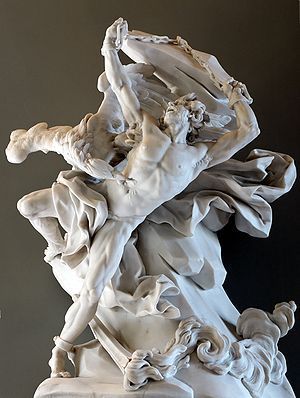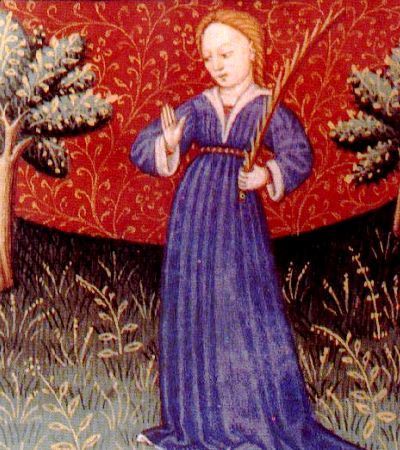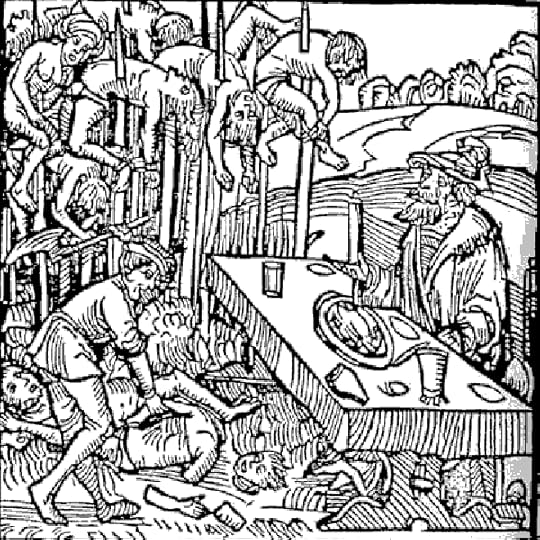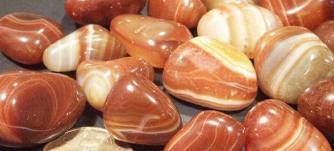Stephen Morris's Blog, page 52
September 23, 2013
Mabon, the Autumnal Equinox

Goose and apples are traditional foods for the celebrations of the autumnal equinox, Mabon, and Michaelmas.
In many cultures, the September equinox is a sign of fall (autumn) in the northern hemisphere. In Greek mythology fall is associated with when the goddess Persephone returns to the underworld to be with her husband Hades. It was supposedly a good time to enact rituals for protection and security as well as reflect on successes or failures from the previous months.
In the Celtic pracitce, the autumnal equinox, is also known as ‘Mabon,’ the Welsh God who symbolized the male fertilizing principle in the Welsh myths. Some mythologists equate him as the male counterpart for Persephone.
Mabon ap Modron is a figure of Welsh mythology, the son of Modron. Both he and his mother were likely deities in origin, descending from a divine mother–son pair. His name is related to the Romano-British god Maponos, whose name means “divine son”; Modron, in turn, is likely related to the Gaulish goddess Dea Matrona.
Mabon was a common name in medieval Wales, and it is difficult to determine whether the various references to Mabons in poetry and the Triads are to the same character. The most important appearance of Mabon ap Modron is in the prose tale Culhwch and Olwen, associated with the Mabinogion and perhaps authored around 1100. King Arthur’s men must recruit Mabon to fulfill the demands of Ysbaddaden the giant before he will allow his daughter Olwen marry the protagonist Culhwch. Mabon is the only one who can hunt with the dog Drudwyn, in turn the only dog who can track the great boar Twrch Trwyth.
However, Mabon has been missing since he was three nights old, when unknown intruders stole him from between his mother and the wall. Arthur determines that he and his men will find and rescue Mabon. Mabon’s whereabouts are unknown even to Britain’s oldest and wisest animals, but finally Arthur’s followers are led to the Salmon of Llyn Llyw, the oldest animal of all. The enormous salmon carries Arthur’s men Cei and Bedwyr downstream to Mabon’s prison in Gloucester; they hear him through the walls, singing a lamentation for his fate. The rest of Arthur’s men launch an assault on the front of the prison, while Cei and Bedwyr sneak in the back and rescue Mabon. Mabon subsequently participates in the hunt for the Twrch Trwyth.
September 19, 2013
Dracula Arrives in New York
The play Dracula opened in New York’s Schubert Theatre on September 19, 1927. Originally a 1924 stage play adapted by Hamilton Deane from the novel of the same name by Bram Stoker, it was substantially revised by John L. Balderston in 1927. It was the first adaptation of the novel authorised by Stoker’s widow, and has influenced many subsequent adaptations.
In 1927 the play was brought to Broadway by Horace Liveright, who hired John L. Balderston to revise the script for American audiences. The American production starred Bela Lugosi in his first major English-speaking role, with Edward Van Sloan as Van Helsing; both actors reprised their roles in the 1931 film version, which drew on the Deane-Balderston play.
In addition to radically compressing the plot, the 1927 rewrite by Balderston, reduced the number of significant characters, combining Lucy Westenra and Mina Murray into a single character, making John Seward this Lucy’s father, and disposing of Quincey Morris and Arthur Holmwood. In Dean’s original version Quincey was changed to a female to provide work in the play for more actresses.
The play was revived in 1977, in a production featuring set and costume designs by Edward Gorey and starring Frank Langella as Dracula. The production won Tony Awards for Best Revival and Best Costume Design, and was nominated for Best Scenic Design and Best Leading Actor in a Play (Langella). Langella, like Lugosi, went on to reprise the role in the 1979 film version. Subsequent actors in the title role for the Broadway revival included David Dukes, Raul Julia and Jean LeClerc, while the London production starred Terence Stamp and American touring companies starred Martin Landau and Jeremy Brett.
(Related to the theatrical opening of Dracula, the popular television series The Addams Family debuted on September 18, 1964 and Romania issued a stamp depicting Vlad Dracul in honor of the 500th anniversary of the founding of Bucharest on September 20, 1959.)
September 17, 2013
Come to the Brooklyn Book Fair on September 22!
I will have half-price discount copies of WOLFBANE, the novella that sets the stage for the adventures of Alexei the werewolf, at Booth #185. Find me beneath the “Stephen Morris, Author” sign, on SEPTEMBER 22, 2013 from 10am-6pm. The festival will be held
Brooklyn Borough Hall and Plaza
209 Joralemon Street, Brooklyn NY 11201
The festival can be easily reached by several subway lines:
take the M, R, 2, 3, 4, or 5 trains to Court St/Borough Hall, or take the A, C, F trains to Jay St/Borough Hall.
More information about the annual festival can be found here.
If you cannot drop by and say, “Hello!” at the Book Festival, you can order WOLFBANE on Amazon here.
Discount copies of the Come Hell or High Water trilogy will be available at the Brooklyn Book Festival as well. Buy a set of the entire trilogy and get a FREE copy of Wolfbane!
September 12, 2013
Sapphire, the birthstone of September

Prometheus, depicted in this 1762 statue by Nicolas Sebastien Adam, was punished for stealing a sapphire from Olympus as well as fire.
September’s birthstone is also the birthstone for the astrological signs of Taurus, Virgo, Sagittarius and Pisces. The sapphire is the gem commemorating the 5th, 23rd and 45th wedding anniversaries.
Ancient folklore claims the sapphire bestows spiritual enlightenment and inner peace upon its wearer, as well as providing protection from harm. Because sapphires were thought to hold the power of wisdom, those wearing these gemstones would be guided to make the correct decision when faced with obstacles and difficult situations. Sapphires have been credited with the ability to detect purity and faith, as well as possessing the power to foretell the future and attract divine favour. Because the sapphire represents purity of purpose and deed, medieval-era church officials chose the gemstone to decorate their rings and sceptres.
The Ten Commandments handed to Moses by God in the Bible were said to have been carved on sapphire. Different English Bible translations believe the word “Sapir” in Exodus 28:18 is “sapphire”, referring to the stone on the garments of the priest of the Issacar tribe.
Eastern cultures treasure the sapphire as a talisman for warding off evil; in India a sapphire necklace affords its wearer powerful protection. In the West, the unique star sapphire is known as the Stone of Destiny, with the three lines crossed lines that form the “star” representing Faith, Hope and Charity. Such is the power of the star sapphire it is believed the gemstone will continue to guide and protect its first wearer even after it has been passed to other people.
Greek mythology claims that when Prometheus stole fire from the gods to give to mortals he also stole a sapphire. The dreadful punishment exacted by the gods for this misdeed would indicate the sapphire failed to protect the unfortunate Prometheus. Ancient Persians believed the earth rested on a giant blue sapphire, and the gemstone’s colour was reflected onto the sky.
In the Middle Ages blue gemstones were used to treat eye diseases and as an antidote to poison. Members of royalty wore sapphire around their necks to protect them from envy, poison and harm. Sapphires were considered to be an effective treatment for colic and rheumatism, as well as being used to ease certain mental illnesses.
September 9, 2013
Aster and Morning Glory: September’s Blossoms
Aster, one of the “birth flowers” of September, is also called Michaelmas Daisy.
September’s birth flowers are the aster and the morning glory. Asters, also called a “michaelmas daisy” for the Michaelmas holiday on September 29, are a feminine flower associated with the element of water and the goddess Aphrodite. They are used in sachets to attract love. You can also give blooming asters to someone whose love you wish to attract.
Morning glory, however, while also associated with water is a masculine flower and attractive to Saturn. Its seeds can be placed beneath pillows to stop nightmares and a garden that contains morning glory is a source of peace and happiness. Morning glory root can also be used in a sachet to attract wealth (anoint it with mint oil first). The roots can also be steeped in oil and the oil used to anoint items to be used in magical practice.
September 4, 2013
Happy New Year: Shofars and Possesions

A man blows the shofar.
This year the Jewish celebration of the High Holy Days falls in very early September. Considered the birthday of Adam and the “Days of Awe” during which God judges the world to decide who will live or die during the coming 12 months, the celebration of the New Year and Day of Atonement are especially solemn. One of the most noted New Year’s practices is the blowing of the shofar during the New Year services. When the walls of Jericho fell, it was in response to the blowing of shofars by the army of Israel. Hebrew folklore also indicates that blowing a shofar was used to implore God to bring rain during times of drought and serve as a warning blast to the people when a disaster was looming on the horizon. It was a heavenly shofar that sounded when God gave Moses the 10 Commandments on Mt. Sinai and it is a shofar the angels will blow to announce the End of the World.
Because of the association of the High Holy Days with repentance, judgement, and death it also a time when the division between the living and the dead is considered thin indeed. One way the dead or other spirits interact with the living is by possesion. Some spirits that attack the living are ghosts but others are demonic entities. Some demons are fallen angels but according to some Kabbalistic thought, a man who masturbates, has a “wet dream,” or has a seminal emission under other unhallowed circumstances, his semen gives birth to “spiritual children” which gravitate against him [and his family] as negative spiritual forces. The man may redeem these spiritual children through remorse and repentance and end their damaging influence upon himself and his loved ones.
A ghost that posses the living is called a “dybbuk.” The term first appears in a number of 16th century writings, and earlier accounts of possession (such as that given by Josephus) were of demonic possession rather than that by ghosts. The 16th century accounts advocated orthodoxy among the populace as a way to prevent possession by a dybbuk. For example, it was suggested that a sloppily made mezuzah or entertaining doubt about Moses’ crossing of the Red sea opened one’s household to dybbuk possession.
There are also other accounts of soul transmigration in Jewish mythology. In contrast to the dybbuk, the “Ibbur” is a positive possession, which happens when a righteous soul temporarily possesses a body. This is always done with consent, so that the soul can perform a good deed, known as a “mitzvah.” Some kabbalists put forth the idea that a soul must live through many lives before it gains the wisdom to rejoin with God.
August 29, 2013
Virgo, the Virgin

(Image of virgin-martyr taken from 15th century astrology handbook)
Virgo is the sixth astrological sign in the Zodiac. The sun transits this area on average between August 23 to September 23 each year. The planet said to be ruler of Virgo is Mercury and as portrayed in ancient Roman mythology, Mercury wasn’t one to sit still for long. This swift-footed god was a bundle of energy, both physically and mentally, and that pretty much sums up Virgo’s makeup
The constellation of Virgo is representative of many identities, all related to maidens, purity and fertility. She was originally associated to Dike, also known as Justice, daughter of Zeus and Themis, who was once the Mistress of All-Divine Order and Law prior to the Olympians. Dike initially lived among mankind but withdrew when they no longer upheld justice.
In Greek mythology, too, there is a similar theme. Persephone, daughter of Zeus and Demeter, had been abducted and taken to the underworld by Hades. In revenge her mother ruined the harvests, the earth became infertile and the people were starving. Zeus was forced to issue a decree stating that Persephone should spend only a short time each year in the underworld, and when she was released Demeter permitted Nature to resume its natural course.
Virgos, more than any other sign, were born to serve, and it gives them great joy. They are also tailor-made for the job, since they are industrious, methodical and efficient. The sense of duty borne by these folks is considerable, and it ensures that they will always work for the greater good. Virgos enjoy indulging their practical and logical side and poring over their projects to the nth degree. To say these folks are good at fact-finding almost understates the case. Those born under this sign are also able communicators and use their mental acuity to maximum advantage.
August 27, 2013
Beheading of John The Baptist

The Beheading of John the Baptist (detail), possibly by Tomasino da Vimercate, about 1410
The Roman Catholic and Orthodox churches commemorate of the Beheading of St. John the Baptist on August 29. However, in Italian folklore the story of the daughter of Herodias became attached to June 23, St John’s Eve, which is the night before the Feast Day of St. John the Baptist, June 24. (Usually, a feast day of a saint commemorated the death of that saint to celebrate her/his martyrdom; the feast of St. John the Baptist is one of the very few saints’ days to mark the anniversary of a saint’s birth. Click here for my earlier post about St. John’s Nativity and Midsummmer. Click here for another post about Midsummer and St. John’s Wort.) In Rome, youths would gather in front of the cathedral of Basilica of St. John Lateran on the night of June 23, because Herodias traveled in the air.
“Salome of the Seven Veils” is the name by which the “daughter of Herodias” is generally known in modern American culture. J.B. Andrews in his 1897 folklore article (Neapolian Witchcraft, Folklore Transactions of the Folklore Society, Vol III March, 1897 No.1) wrote:
It is believed that at midnight then [St. John Baptist's Eve, June 23] Herodiade may be seen in the sky seated across a ray of fire, saying:
” Mamma, mamma, perche` lo dicesti?”
“Figlia, figlia, perche’ lo facesti? “
“Herodiade” or “Erodiade” is the Italian version of the name Herodias.
Sabina Magliocco in her incredible article Who Was Aradia? The History and Development of a Legend, The Pomegranate (see The Journal of Pagan Studies, Issue 18, Feb. 2002) explained what Herodiade was doing in the airs on June 23, the Eve of St. John Baptist’s Feast Day:
According Sabina Magliocco, there was an early Christian legend or folklore derived from the bibical account (Matthew 14:3-11, Mark 6:17-28) of Herodias and Herodias’ daughter. When the head of the saint was brought forth on a platter, she-who-danced-for-the-head-of-the-Baptist had a fit of remorse, weeping and bemoaning her sin. A powerful wind began to blow forth from the saint’s mouth, so strong that it blew the famous dancer up into the air, where she is condemned to wander.
Titus Flavius Josephus, a first-century Jewish historian provides the name of stepdaughter and niece of Herod Antipas as Salome, but Josephus makes no mention of the infamous dance. Josephus in his Antiquities of the Jews recounted that after the excution of John that Herod, Herodias, and her daughter Salome were exiled Lugdunum, near Spain.
However, the name “Salome” does not appear in the biblical accounts of the beheading of John the Baptist. In the Latin Vulgate Version, the girl is refered to as the “daughter of the said Herodias.”
At some point, the “daughter of Herodias” and “Herodias” became conflated in folklore in early medieval Europe.
Probably because the holiday of St John the Baptist was widely celebrated during the Middle Ages, a great deal of religious folklore surrounds Herodias. Magliocco also explained:
Diana in the Canon Episcopi, a document attributed to the Council of Ancyra in 314 CE, but probably a much later forgery, since the earliest written record of it appears around 872 CE (Caro Baroja, 1961:62). Regino, Abbot of Pr¸m, writing in 899 CE, cites the Canon, telling bishops to warn their flocks against the false beliefs of women who think they follow “Diana the pagan goddess, or Herodias” on their night-time travels. These women believed they rode out on the backs of animals over long distances, following the orders of their mistress who called them to service on certain appointed nights. Three centuries later, Ugo da San Vittore, a 12th century Italian abbot, refers to women who believe they go out at night riding on the backs of animals with “Erodiade,” whom he conflates with Diana and Minerva (Bonomo, 1959:18-19).
Eventually there developed a widespread belief that Herodias was a the supernatural leader of a supposed cult of witches, apparently asociated with or synonymous with the legendary witch-queens Diana, Holda, Abundia, and many others. In Italy, Raterius of Liegi, Bishop of Veronia in the 9th century c.e. complained that many folk believed that Herodias was a queen or goddess and that they also claimed a third of the earth was under the dominion of Herodias. Herodias was supposed to preside over the night assembly or night flight.
In parts of Italy, the dew formed on St. John’s Eve was often said to represent the tears of the daughter of Herodias. This dew was believed to have healing virtues and promote fecundity. June 23 was also known as la notte delle streghe. It was once customary in Rome to build bonfires outside the Basilica of St. John Lateran in anticipation of the night flight led by Herodias. (Read my previous post on the bonfires of June 23 here.)
August 22, 2013
Sardonyx
Onyx is a chalcedony quartz that is mined in Brazil, India, California and Uruguay. Originally, almost all colors of chalcedony from white to dark brown and black were called onyx. Today when we think of onyx we often preface the word with black to distinguish it from other varieties of onyx that come in white, reddish brown, brown and banded. A variety of onyx that is reddish brown with white and lighter reddish bands is known as sardonyx, from the Greek sarx (flesh) because of these flesh tones in the gem.
The name also comes from the Greek word onyx which means nail of a finger or claw. Legend says that one day while Venus was sleeping Eros/Cupid cut her fingernails and left the clippings scattered on the ground. Because no part of a heavenly body can die, the gods turned them into stone which later became known as onyx.
Sardonyx is said to grant intelligence and courage, dispel nightmares and meloncholy, and break curses. Sardnyx is one of the stones in the ‘Breastplate of Judgement’ of Aaron, described in the Bible (Exodus 28:15-30). Sardonyx is also included in the listing of the gems of the King of Tyre (Ezekiel 28:13) and is one of the gems the New and Heavenly Jerusalem is said to be built of (the book of Revelation).
One of the earliest writers to associate the symbolism of the gems given in Revelation with the apostles is Andrew, bishop of Caeserea. He gives says the sardonyx represents James, the (step) brother of Christ, a son of Joseph from his first marriage.
During the Renaissance in Europe it was believed that this stone gave speakers eloquence when talking. In Ancient Greece people used to carve them into the shape of scarab beetles, a mythological creature that was believed to eat people! The gem also has many links with royalty and it is said that Queen Elizabeth I gave the Earl of Essex a large Sardonyx gold ring as a present.
August 19, 2013
Vlad the Impaler

1499 German woodcut showing Vlad, the Son of the Dragon dining among the impaled corpses of his victims.
History has condemned Vlad the Impaler (known as Vlad Dracul, the Son of the Dragon, as his father was a knight of the Order of the Dragon) for killing many (about 500) of the nobility who did not like or agree with him. He was also reputedly trying to eliminate the povertry-stricken from society. He invited all the blind, handicapped, elderly, poor, etc. to a party (similar to a charity dinner) in a special house. All those invited entered the house, ate and drank. Afterward, Vlad asked them if they wanted to cease being a burden to their loved ones and end their poverty. All the people present agreed. When he heard that, he ordered the house locked, set on fire and all the people within burnt alive.
His first major act of revenge was aimed at the boyars of Tirgoviste for for not being loyal to his father. On Easter Sunday he invited all the boyar families who had participated to the royal celebration. He asked them how many princes had ruled in their lifetimes. They said they had lived through many reigns. Shouting that this was their fault because of their plotting, Vlad had them all arrested on the spot. He impaled the older ones on stakes while forcing the others to march from the capital to the town of Poenari. This fifty-mile trek was quite grueling and no one was permitted to rest until they reached destination. Vlad then ordered boyars to build him a fortress on the ruins of an older outpost overlooking the Arges River. Many died in the process, and therefore Vlad succeeded in creating a new nobility and obtaining a fortress for future emergencies. What is left today of the building is identified as Poenari Fortress (Cetatea Poenari).
A German story about Brasov describes a masacre of 30,000 on August 24, 1460, says that Vlad the Impaler was sitting at a table filled with food and drink. In front of him, on a hill, some of his soldiers began to impale a number of the Saxon traders simply because of his dislike for them, and because of their attempts to remove him from the throne of Walachia. Another story describes the impaled bodies looking like a forest.
(Click here for a detailed article on Vlad the Impaler’s life.)





